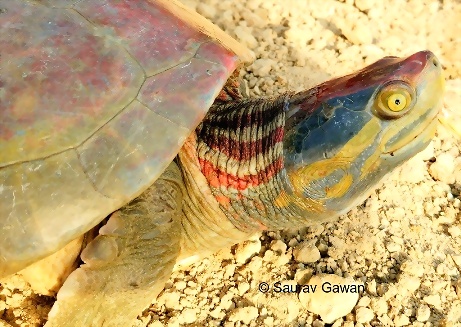
views
Two native species of freshwater turtles are now included in the CITES list of species threatened with extinction after India’s proposal to protect their last remaining population from international commercial trade was adopted by the Conference of Parties (CoP) at its ongoing 19th Meeting in Panama.
Facing intense exploitation over the years, the two freshwater species — Red-Crowned Roofed Turtle (Batagur Kachuga) and Leith’s Softshell Turtle (Nilssonia Leithi) — have been fighting a tough battle for survival. The shy reptiles, who are known to retreat inside their shells to get away from people or animals, have witnessed a drastic decline of over 90 per cent in the last three decades. While their hunting is already banned in India, their poaching and illegal trade continues unabated.
WHY IS THIS IMPORTANT?
The Convention on International Trade in Endangered Species of wild fauna and flora (CITES) is an international agreement between 184 countries, including India, to ensure that global trade of plants or wild animals does not lead to extinction of the species.
Though legally binding on all parties, it can only be implemented once countries have their domestic legislation in place. The governments interact once every two-three years in meetings called CoP to review the list of animals/plants under the three Appendices providing different degrees of protection.
At this year’s CoP, which is underway in Panama, India had proposed to move the two turtle species from Appendix II to Appendix I of CITES to provide them a greater degree of protection. The proposal has finally been adopted.
WHAT IS APPENDIX I?
Bringing any species under Appendix I essentially means that it is now declared “threatened with extinction” under the international trade agreement. This means CITES will ensure there is no commercial trade of the species in any form. It would also ensure that international trade in captive-bred specimens only takes place from registered facilities and higher penalties are provided for illegal trade of the species.

The move is essentially aimed at improving the little chance of survival of these critically endangered species. While both the turtles have already been protected under Schedule IV of the Wild Life (Protection) Act, 1972, from hunting as well as trade, their poaching and illegal trade is proving to be a daunting challenge. Every year, massive seizures of thousands of specimens are being reported from across the country. Identifying the species from the seized specimens is also a serious challenge.
KNOW THE TWO TURTLES
Mostly known to be shy, very little is known about the general nature of turtles which are among the world’s most trafficked species for their meat or pet trade. They mature late and grow for over 25 years which naturally makes them more susceptible to extinction.
Their intensive exploitation for calipee — the yellow gelatinous part next to its lower shell — which is eaten as a ‘delicacy’ in several places has threatened their survival. They are illegally consumed in India and are widely poached for meat. One such study based on reported seizures in India found that as many as 11,000 tortoises and freshwater turtles were poached and illegally traded every year between 2009 and 2019.
The Red-Crowned Roofed Turtle (Batagur Kachuga) was once widespread in the main riverine sections of India’s Ganga basin, Bangladesh and Nepal. But its number has now collapsed to less than 500 as per International Union for Conservation of Nature (IUCN), which has already included it in its Red List. It is already extinct from Bangladesh, and the only viable population is now found in Madhya Pradesh’s National Chambal Sanctuary where its habitat is under threat from sand mining, hydroelectric infrastructure plans, collection and accidental mortality. The males are widely traded as pets because of their bright colouration.
Leith’s Softshell Turtle (Nilssonia Leithi) is only found in the rivers and reservoirs of south peninsular India. They are relatively large and can grow up to one metre in length.
‘OPERATION TURTSHIELD’
India has been making efforts to conserve the last remaining population — an initiative that has been lauded by CoP19. The Wildlife Crime Control Bureau launched ‘Operation Turtshield’ to combat wildlife crime and illegal trade of turtles in the country and nabbed poachers and those involved in illegal trade of freshwater turtles. At CoP19, the Indian delegation led by Director General Forests (DGF) and Special Secretary CP Goel further reiterated government’s commitment to conserve tortoises and freshwater turtles in the country.
Read all the Latest India News here















Comments
0 comment